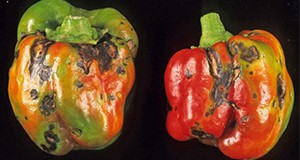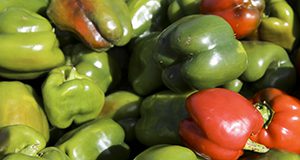Bacterial spot, caused by three species of Xanthomonas, is a limiting disease problem on all peppers. This new 4-page fact sheet provides information on symptoms, causal organism and host resistance, disease cycle and epidemiology, and disease management (including cultural and sanitation practices, chemical control measures and the use of Actigard in chile peppers). Written by Camille McAvoy, Pamela Roberts, and Jeffrey Jones, and published by the UF/IFAS Plant Pathology Department.
https://edis.ifas.ufl.edu/pp362
Tag: Diseases in Pepper
Tomato Brown Rugose Fruit Virus (ToBRFV): A Potential Threat for Tomato Production in Florida
Tobamoviruses are mechanically transmitted plant viruses that cause severe economic damage to vegetable and ornamental crops in Florida and worldwide. While certain tomato cultivars have genetic resistance to the most common tobamoviruses, no commercial tomato cultivars are resistant to tomato brown rugose fruit virus (ToBRFV), a recently described tobamovirus that also infects pepper and eggplant. It is currently unknown how ToBRFV may affect tomato production in Florida. This new 5-page publication of the UF/IFAS Plant Pathology Department describes symptoms of the virus, how it is different from other tobamoviruses, and how it is transmitted, as well as what to do if you think you have ToBRFV in your field. Written by Ozgur Batuman, Salih Yilmaz, Pamela Roberts, Eugene McAvoy, Samuel Hutton, Kishore Dey, and Scott Adkins.
https://edis.ifas.ufl.edu/pp360
Some Common Diseases of Pepper in Florida

Pepper is an important commercial vegetable crop in Florida. During the months of November through May, the country is dependent on Florida for its supply of domestic fresh peppers. But disease problems often limit Florida pepper production. This fact sheet describes the symptoms and provides control recommendations for bacterial spot, phytophthora blight, wet rot, cercospora leaf spot, southern blight, blossom end rot, tobacco mosaic virus, aphid-transmitted viruses, and tomato spotted wilt virus (TSWV). Written by Gary Vallad, Pamela Roberts, Ken Pernezny, and Tom Kucharek. Originally published by the UF Department of Plant Pathology in March 1991, Revised September 2015. (Photo credit: Gerald Holmes, Bugwood.org, CC BY-NC 3.0 US). We would like to extend special thanks to professors emeriti Ken Pernezny and Tom Kucharek for interrupting their shuffleboard schedules to contribute to the revision of this publication.
http://edis.ifas.ufl.edu/vh054
ENY658/IN401 Managing Thrips in Pepper and Eggplant
Revised! ENY-658, a 6-page illustrated fact sheet by Joe Funderburk, Stuart Reitz, Phil Stansly, Dave Schuster, Greg Nuessly, and Norm Leppla, provides pepper and eggplant growers with management information for this serious pest of ornamental, vegetable and fruit crops in the field and greenhouse — biology and ecology, tomato spotted wilt and management programs. Includes references. Published by the UF Department of Entomology and Nematology, October 2009.
http://edis.ifas.ufl.edu/IN401
SL284/SS497 Blossom-End Rot in Bell Pepper: Causes and Prevention
SL-284, a 5-page illustrated fact sheet by George J. Hochmuth and Robert C. Hochmuth, describes one of the most commonly observed disorders of pepper, blossom-end rot (BER) — its symptoms, calcium physiology, calcium deficiency, factors predisposing fruits to BER, and prevention. Includes references. Published by the UF Department of Soil and Water Science, April 2009.
http://edis.ifas.ufl.edu/SS497
PP255/PP171 Host-Plant Resistance and Management of Bacterial Spot of Pepper
PP-255, a 3-page illustrated fact sheet by Ken Pernezny, Jeff Jones, Russell Nagata, and Nikol Havranek, describes the developments in the campaign to develop cultivars resistant to Xanthomonas euvesicatoria. Published by the UF Department of Plant Pathology, June 2008.
http://edis.ifas.ufl.edu/PP171

